A New Strategy for Extracting ENSO Related Signals in the Troposphere and Lower Stratosphere from GNSS RO Specific Humidity Observations
Abstract
1. Introduction
2. Datasets and Methods
2.1. COSMIC GNSS RO Data
2.2. ENSO Indicators
2.3. Methodology
- (1)
- The original daily average data were interpolated into longitude–latitude grid points across the globe at different altitudes in the TLS using the nearest neighbor interpolation with inverse distance weighted method. Applying the method results in an Earth oblateness level error, but the error can be ignored. Owing to the relatively sparse distribution of COSMIC GNSS RO profiles over the polar region, the accuracy of the grid points in this region is lower than that of the other regions. Considering that the horizontal resolution of COSMIC observations is about , and to avoid the impact of tangent point horizontal drift (the drift from altitude 1 km to 10 km is about 102 km, and the drift from 1 km to 20 km is about 136 km [41]) of the COSMIC occultation point, a grid resolution of , which is slightly lower than the actual resolution of the occultation data, was adopted. The gridded specific humidity data are presented for 250 standard pressure levels (from 1000–100 hpa in 5 hpa steps, 100–30 hpa in 1 hpa steps) by linear interpolation from 1000 to 30 hpa (~0–25 km) in the vertical direction.
- (2)
- For each isobaric surface, the specific humidity monthly anomalies at each grid point were extracted through eliminating the annual and month-to-month variations in the monthly specific humidity time series at each point. The annual mean anomalies were obtained by subtracting the mean annual cycle (~372-day cycle) identified via fast Fourier transform at each grid point for the period, June 2006–June 2014. Then, the time series of monthly mean anomalies were obtained by taking the monthly average of the annual mean anomalies. The time series were then smoothed with a 1-2-1 binomial filter to reduce month-to-month variations [13,22].
- (3)
- For each isobaric surface, the monthly mean anomalies at each grid point were filtered by the low-pass filter with different filtering cut-off frequencies. Considering that the data length is 97 months for the period of June 2006–June 2014, the minimum cut-off frequency was set as 1/48.5 (assuming the maximum cycle of ENSORS is 48.5 months), the maximum cut-off frequency was set as 1, and so the cut-off frequency could be set to 1, 1/1.5, 1/2.0, ..., 1/48.5 (unit: 1/month). To determine the optimal cut-off frequency, we required a numerical low-pass filter to eliminate the high frequency signals. The frequency response, , of an ideal low-pass filter can be described by Formula (3).where is the cut-off frequency, and is the frequency of the signals of the monthly mean anomalies. Then, the corresponding impulse responses of an ideal low-pass filter, , obtained using the inverse Fourier transform method can be represented bywhere the time series, , at different cut-off frequencies can be obtained.
- (4)
- For each isobaric surface, the filtered time series of monthly mean anomalies () obtained from Step (3) were analyzed by EOF for all filtering cut-off frequencies. For each filtering cut-off frequency, the cross-correlation was carried out between the time series of EOF components and ONI. The optimal cut-off frequency of the low-pass filter was determined when the maximum absolute value of the correlation coefficient was obtained. The time series of EOF components which have the maximum absolute values of the correlation coefficient with the ONI were regarded as ENSORS.
3. Results and Discussion
3.1. Extracting ENSORS in the TLS
3.2. Response to ENSO in the TLS
3.3. Response to ENSO at an Altitude of 245 hpa across the Globe
3.4. Specific Humidity Response to ENSO in the Vertical Direction
4. Conclusions
Acknowledgments
Author Contributions
Conflicts of Interest
References
- Hanley, D.E.; Bourassa, M.A.; O’Brien, J.J.; Smith, S.R.; Spade, E.R. A quantitative evaluation of ENSO indices. J. Clim. 2003, 16, 1249–1258. [Google Scholar] [CrossRef]
- Lau, K.-M.; Ho, C.-H.; Kang, I.-S. Anomalous Atmospheric Hydrologic Processes Associated with ENSO: Mechanisms of Hydrologic Cycle-Radiation Interaction. J. Clim. 1998, 11, 800–815. [Google Scholar] [CrossRef]
- McPhaden, M.J.; Zebiak, S.E.; Glantz, M.H. ENSO as an Integrating Concept in Earth Science. Science 2006, 314, 1740–1745. [Google Scholar] [CrossRef] [PubMed]
- Ropelewski, C.F.; Halpert, M.S. Precipitation patterns associated with the high index phase of the Southern Oscillation. J. Clim. 1989, 2, 268–284. [Google Scholar] [CrossRef]
- Ropelewski, C.F.; Halpert, M.S. Global and regional scale precipitation patterns associated with the El Niño/Southern Oscillation. Mon. Weather Rev. 1987, 115, 1606–1626. [Google Scholar] [CrossRef]
- Ropelewski, C.F.; Halpert, M.S. Quantifying southern oscillation-precipitation relationships. J. Clim. 1996, 9, 1043–1059. [Google Scholar] [CrossRef]
- Glantz, M.H.; Katz, R.W.; Nicholls, N. Teleconnections Linking Worldwide Climate Anomalies; Cambridge University Press: Cambridge, UK, 1991. [Google Scholar]
- Rasmusson, E.M.; Wallace, J.M. Meteorological Aspects of the El Niño/Southern Oscillation. Science 1983, 222, 1195–1202. [Google Scholar] [CrossRef] [PubMed]
- Cane, M.A. Oceanographic events during El Niño. Science 1983, 222, 1189–1195. [Google Scholar] [CrossRef] [PubMed]
- Neelin, J.D.; Latif, M. El Niño Dynamics. Phys. Today 1998, 51, 32. [Google Scholar] [CrossRef]
- Tasambay-Salazar, M.; OrtizBeviá, M.J.; Alvarez-García, F.J.; RuizdeElvira, A.M. An estimation of ENSO predictability from its seasonal teleconnections. Theor. Appl. Climatol. 2015, 122, 383–399. [Google Scholar] [CrossRef]
- Steiner, A.K.; Lackner, B.C.; Ladstädter, F.; Scherllin-Pirscher, B.; Foelsche, U.; Kirchengast, G. GPS radio occultation for climate monitoring and change detection. Radio Sci. 2011, 46, RS0D24. [Google Scholar] [CrossRef]
- Scherllin-Pirscher, B.; Deser, C.; Ho, S.P.; Chou, C.; Randel, W.; Kuo, Y.H. The vertical and spatial structure of ENSO in the upper troposphere and lower stratosphere from GPS radio occultation measurements. Geophys. Res. Lett. 2012, 39, L20801. [Google Scholar] [CrossRef]
- Angell, J. Comparison of variations in atmospheric quantities with sea surface temperature variations in the equatorial eastern Pacific. Mon. Weather Rev. 1981, 109, 230–243. [Google Scholar] [CrossRef]
- Angell, J.K. Tropospheric temperature variations adjusted for El Niño, 1958–1998. J. Geophys. Res. Atmos. 2000, 105, 11841–11849. [Google Scholar] [CrossRef]
- Yulaeva, E.; Wallace, J.M. The Signature of ENSO in Global Temperature and Precipitation Fields Derived from the Microwave Sounding Unit. J. Clim. 1994, 7, 1719–1736. [Google Scholar] [CrossRef]
- Lackner, B.C.; Steiner, A.K.; Hegerl, G.C.; Kirchengast, G. Atmospheric climate change detection by radio occultation data using a fingerprinting method. J. Clim. 2011, 24, 5275–5291. [Google Scholar] [CrossRef]
- Fernández, N.C.; García, R.R.; Herrera, R.G.; Puyol, D.G.; Presa, L.G.; Martín, E.H.; Rodríguez, P.R. Analysis of the ENSO signal in tropospheric and stratospheric temperatures observed by MSU,1979–2000. J. Clim. 2004, 17, 3934–3946. [Google Scholar] [CrossRef]
- Su, H.; Neelin, J.D.; Meyerson, J.E. Mechanisms for lagged atmospheric response to ENSO SST forcing. J. Clim. 2005, 18, 4195–4215. [Google Scholar] [CrossRef]
- Christy, J.R.; Drouilhet, S.J., Jr. Variability in daily, zonal mean lower-stratospheric temperatures. J. Clim. 1994, 7, 106–120. [Google Scholar] [CrossRef]
- Free, M.; Seidel, D.J. Observed El Niño–Southern Oscillation temperature signal in the stratosphere. J. Geophys. Res. 2009, 114, D23108. [Google Scholar] [CrossRef]
- García-Herrera, R.; Calvo, N.; Garcia, R.R.; Giorgetta, M.A. Propagation of ENSO temperature signals into the middle atmosphere: A comparison of two general circulation models and ERA-40 reanalysis data. J. Geophys. Res. 2006, 111, D06101. [Google Scholar] [CrossRef]
- Teng, W.-H.; Huang, C.-Y.; Ho, S.-P.; Kuo, Y.-H.; Zhou, X.-J. Characteristics of global precipitable water in ENSO events revealed by COSMIC measurements. J. Geophys. Res. Atmos. 2013, 118, 8411–8425. [Google Scholar] [CrossRef]
- Sun, Y.-Y.; Liu, J.-Y.; Tsai, H.-F.; Lin, C.-H.; Kuo, Y.-H. The Equatorial El Niño-Southern Oscillation Signatures Observed by FORMOSAT-3/COSMIC from July 2006 to January 2012. Terr. Atmos. Ocean. Sci. 2014, 25, 545–558. [Google Scholar] [CrossRef]
- Rasmusson, E.M.; Carpenter, T.H. Variations in Tropical Sea Surface Temperature and Surface Wind Fields Associated with the Sourthern Oscillation/El Nino. Mon. Weather Rev. 1982, 110, 354–384. [Google Scholar] [CrossRef]
- Lau, K.M.; Ho, C.H.; Chou, M.D. Water vapor and cloud feedback over the tropical oceans: Can we use ENSO as a surrogate for climate change? Geophys. Res. Lett. 1996, 23, 2971–2974. [Google Scholar] [CrossRef]
- Trenberth, K.E.; Caron, J.M. The Southern Oscillation revisited: Sea level pressures, surface temperatures, and precipitation. J. Clim. 2000, 13, 4358–4365. [Google Scholar] [CrossRef]
- Sokolovskiy, S.V.; Rocken, C.; Lenschow, D.H.; Kuo, Y.-H.; Anthes, R.A.; Schreiner, W.S.; Hunt, D.C. Observing the moist troposphere with radio occultation signals from COSMIC. Geophys. Res. Lett. 2007, 34, L18802. [Google Scholar] [CrossRef]
- Ahrens, C.D. Meteorology Today: An Introduction to Weather, Climate, and the Environment; Cengage Learning: Boston, MA, USA, 2012. [Google Scholar]
- Fukuoka, A. The Central Meteorological Observatory, A study on 10-day forecast (A synthetic report). Geophys. Mag. 1951, 22, 177–208. [Google Scholar]
- Lorenz, E.N. Empirical Orthogonal Functions and Statistical Weather; Massachusetts Institute of Technology: Cambridge, MA, USA, 1956. [Google Scholar]
- Aires, F.; Chédin, A.; Nadal, J.P. Independent component analysis of multivariate time series: Application to the tropical SST variability. J. Geophys. Res. 2000, 105, 17437–17455. [Google Scholar] [CrossRef]
- Burgers, G.; Stephenson, D.B. The “normality” of El Niño. Geophys. Res. Lett. 1999, 26, 1027–1030. [Google Scholar] [CrossRef]
- Rocken, C.; Kuo, Y.-H.; Schreiner, W.S.; Hunt, D.; Sokolovskiy, S.; McCormick, C. COSMIC System Description. Terr. Atmos. Ocean. Sci. 2000, 11, 21–52. [Google Scholar] [CrossRef]
- Kursinski, E.R.; Hajj, G.A.; Schofield, J.T.; Linfield, R.P.; Hardy, K.R. Observing Earth’s atmosphere with radio occultation measurements using the Global Positioning System. J. Geophys. Res. 1997, 102. [Google Scholar] [CrossRef]
- Kursinski, E.R.; Hajj, G.A.; Leroy, S.S.; Herman, B. The GPS Radio Occultation Technique. Terr. Atmos. Ocean. Sci. 2000, 11, 53–114. [Google Scholar] [CrossRef]
- Smith, E.K.; Weintraub, S. The constants in the equation for atmospheric refractive index at radio frequencies. Proc. IRE 1953, 41, 1035–1037. [Google Scholar] [CrossRef]
- Poli, P.; Joiner, J.; Kursinski, E.R. 1DVAR analysis of temperature and humidity using GPS radio occultation refractivity data. J. Geophys. Res. 2002, 107. [Google Scholar] [CrossRef]
- Healy, S.; Eyre, J. Retrieving temperature, water vapour and surface pressure information from refractive-index profiles derived by radio occultation: A simulation study. Q. J. R. Meteorol. Soc. 2000, 126, 1661–1683. [Google Scholar] [CrossRef]
- Peixoto, J.P.; Oort, A.H. The climatology of relative humidity in the atmosphere. J. Clim. 1996, 9, 3443–3463. [Google Scholar] [CrossRef]
- Ho, S.-P.; Zhou, X.-J.; Kuo, Y.-H.; Hunt, D.; Wang, J.-H. Global Evaluation of Radiosonde Water Vapor Systematic Biases using GPS Radio Occultation from COSMIC and ECMWF Analysis. Remote Sens. 2010, 2, 1320–1330. [Google Scholar] [CrossRef]
- Sun, B.; Reale, A.; Seidel, D.J.; Hunt, D.C. Comparing radiosonde and COSMIC atmospheric profile data to quantify differences among radiosonde types and the effects of imperfect collocation on comparison statistics. J. Geophys. Res. Atmos. 2010, 115, D23104. [Google Scholar] [CrossRef]
- Wang, B.R.; Liu, X.Y.; Wang, J.K. Assessment of COSMIC radio occultation retrieval product using global radiosonde data. Atmos. Meas. Tech. 2013, 6, 1073–1083. [Google Scholar] [CrossRef]
- Trenberth, K.E.; Stepaniak, D.P. Indices of El Niño evolution. J. Clim. 2001, 14, 1697–1701. [Google Scholar] [CrossRef]
- Jin, E.K.; Kinter, J.L., III; Wang, B.; Park, C.-K.; Kang, I.-S.; Kirtman, B.P.; Kug, J.-S.; Kumar, A.; Luo, J.-J.; Schemm, J.; et al. Current status of ENSO prediction skill in coupled ocean–atmosphere models. Clim. Dyn. 2008, 31, 647–664. [Google Scholar] [CrossRef]
- Barnston, A.G.; Tippett, M.K.; L’Heureux, M.L.; Li, S.; DeWitt, D.G. Skill of real-time seasonal ENSO model predictions during 2002-11: Is our capability increasing? Bull. Am. Meteorol. Soc. 2012, 93, 631–651. [Google Scholar] [CrossRef]
- Tasambay-Salazar, M.; OrtizBeviá, M.J.; Alvarez-García, F.J.; de Elvira, A.M.R. The Niño3. 4 region predictability beyond the persistence barrier. Tellus A 2015, 67. [Google Scholar] [CrossRef]
- Oort, A.H.; Yienger, J.J. Observed Interannual Variability in the Hadley Circulation and Its Connection to ENSO. J. Clim. 1996, 9, 2751–2767. [Google Scholar] [CrossRef]
- Wessel, P.; Smith, W.H.F. New, improved version of generic mapping tools released. EOS Trans. AGU 1998, 79, 579. [Google Scholar] [CrossRef]

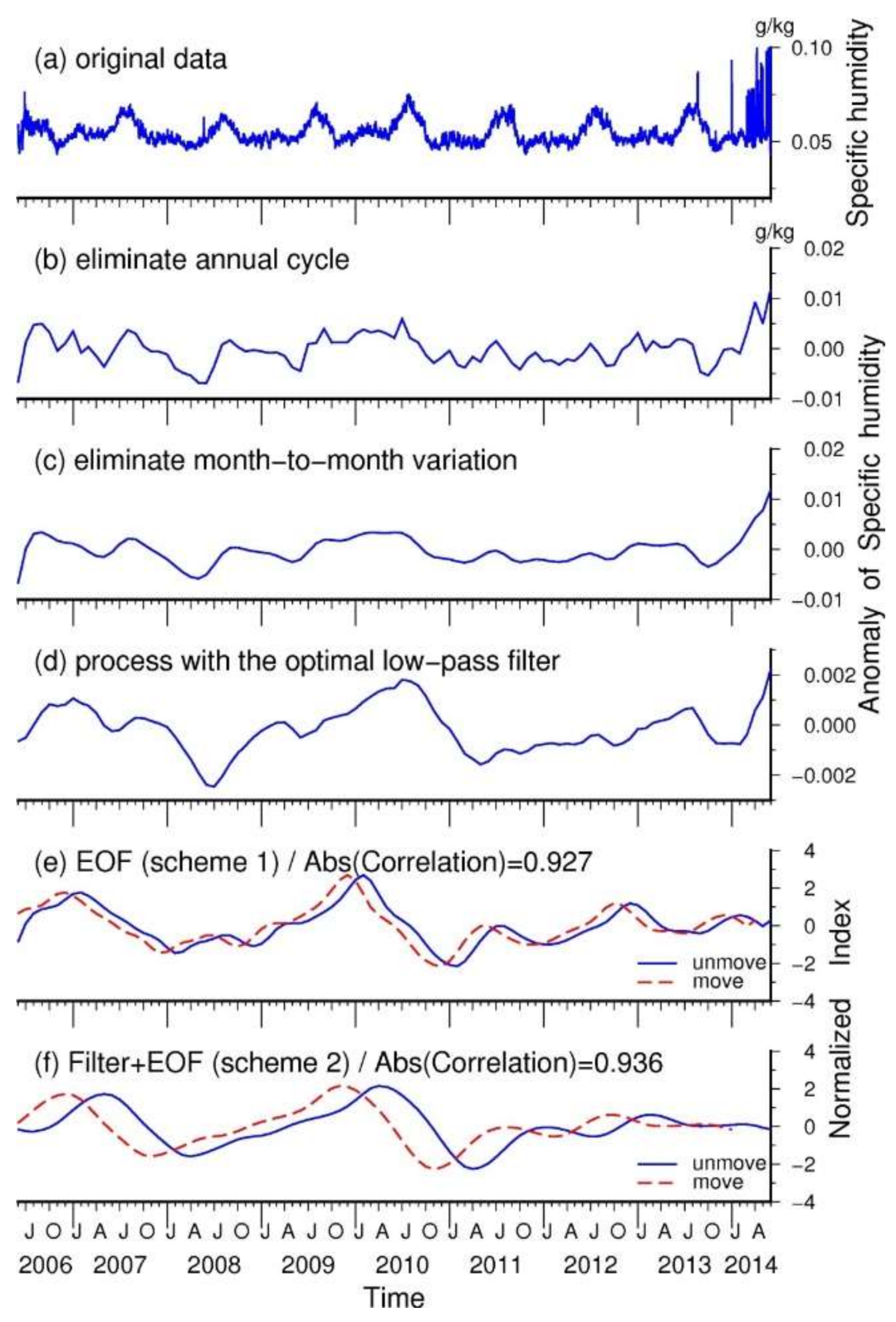
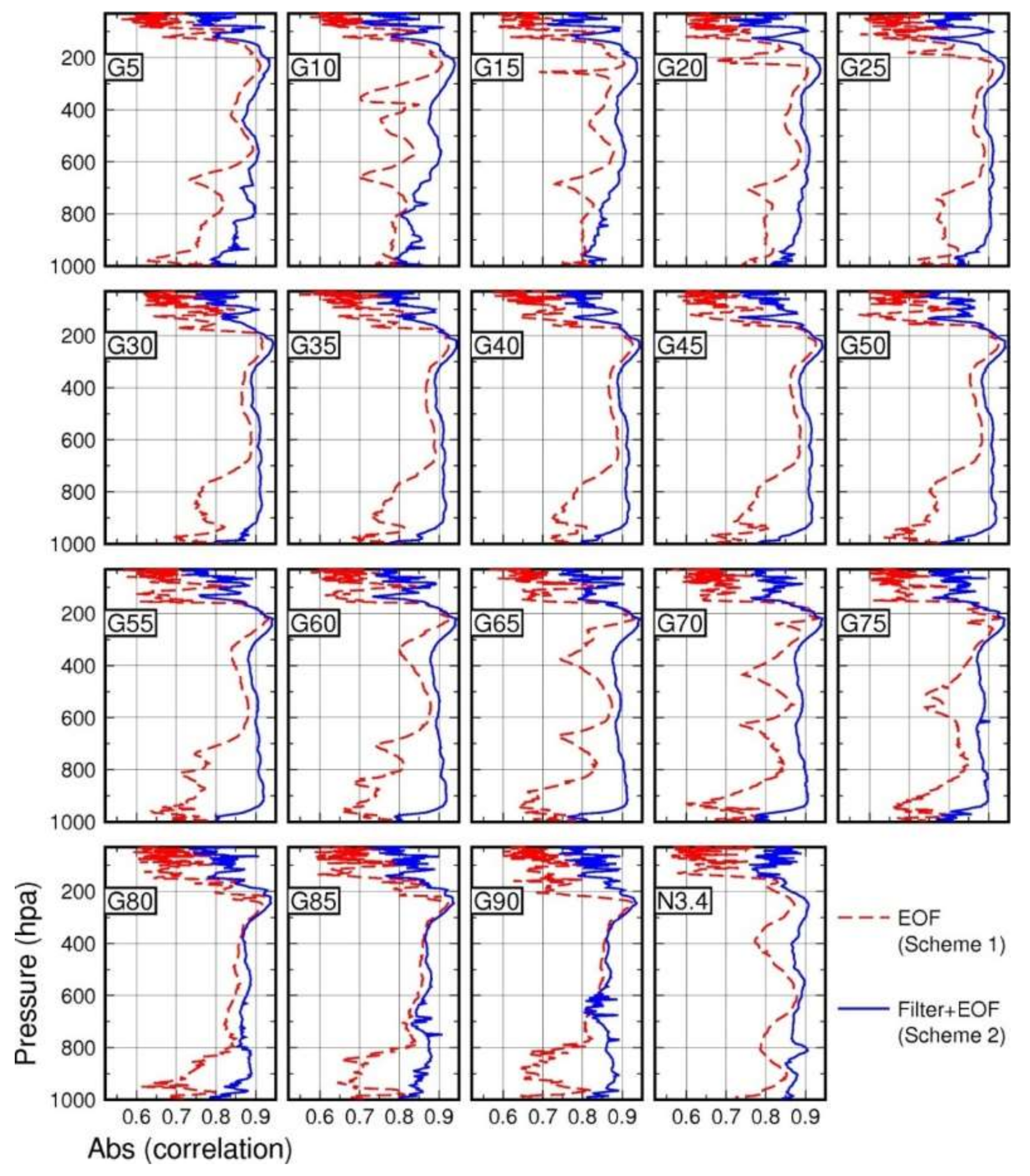

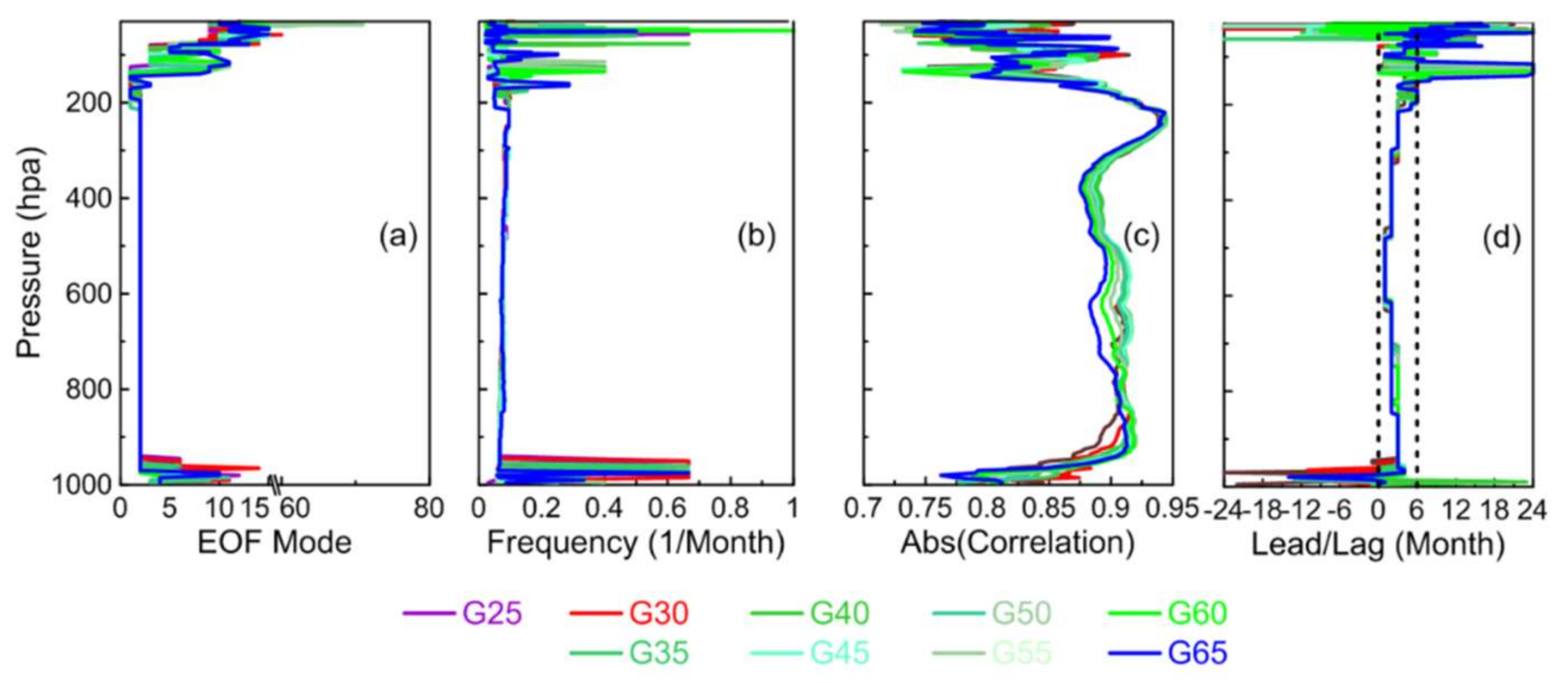
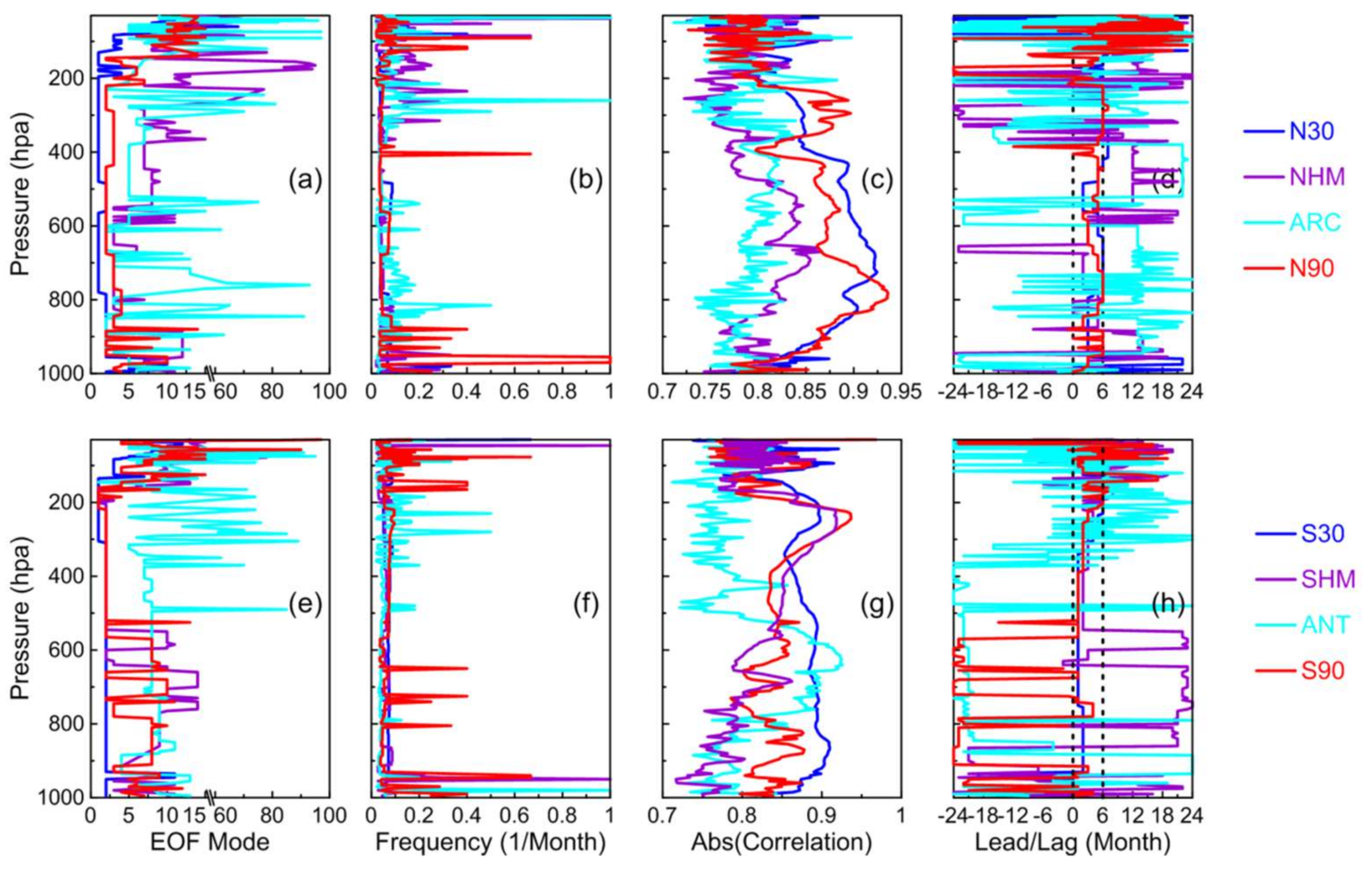
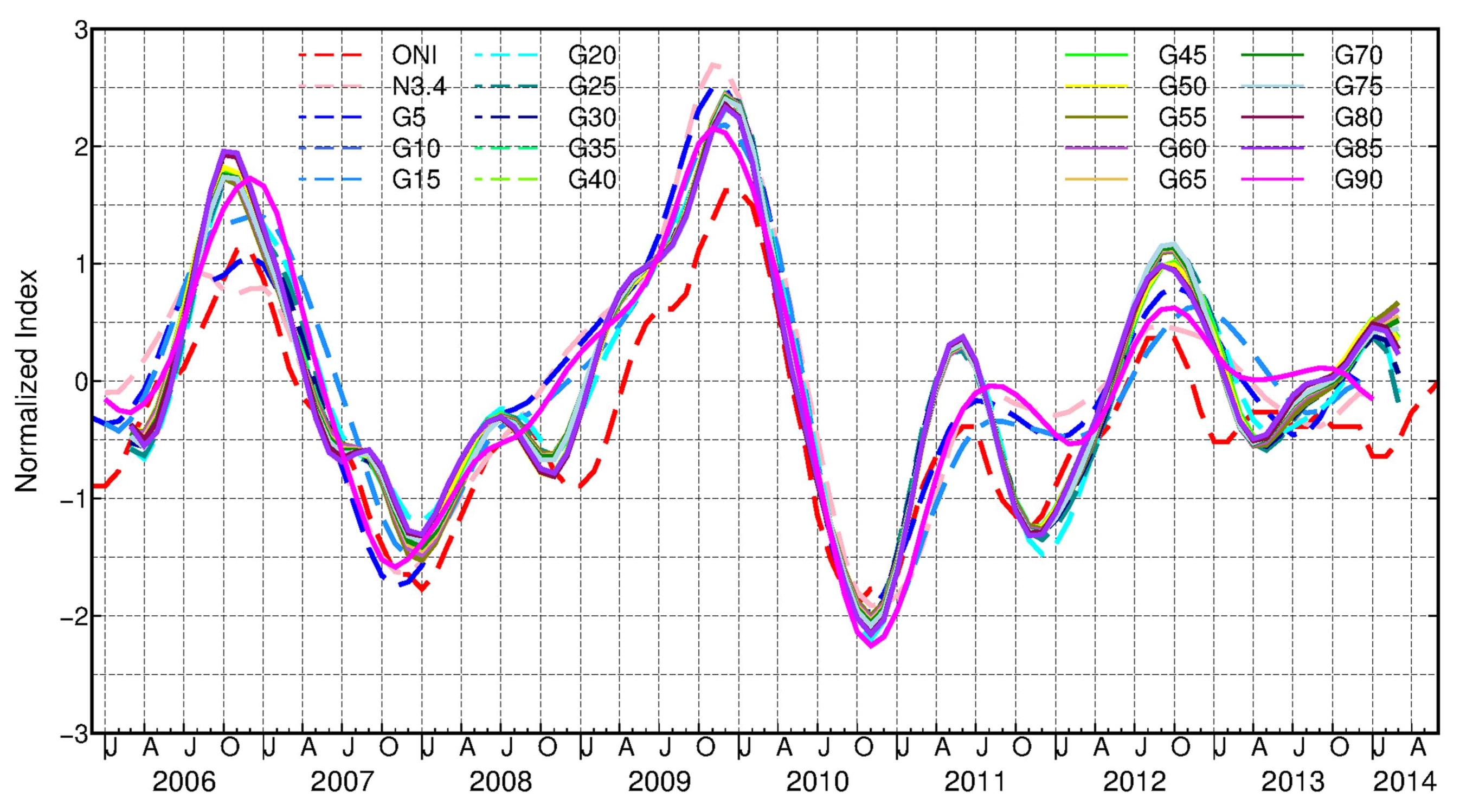
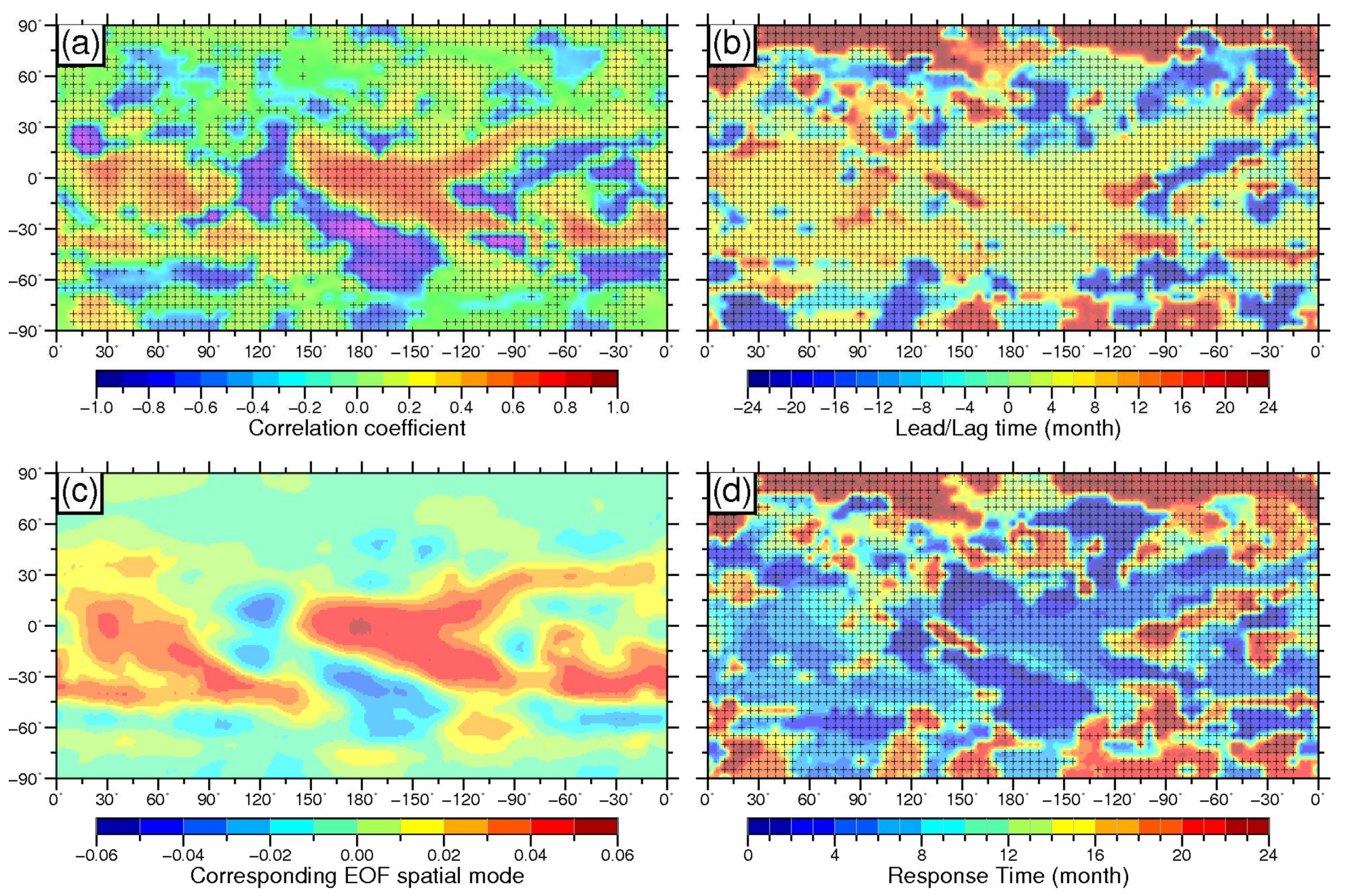
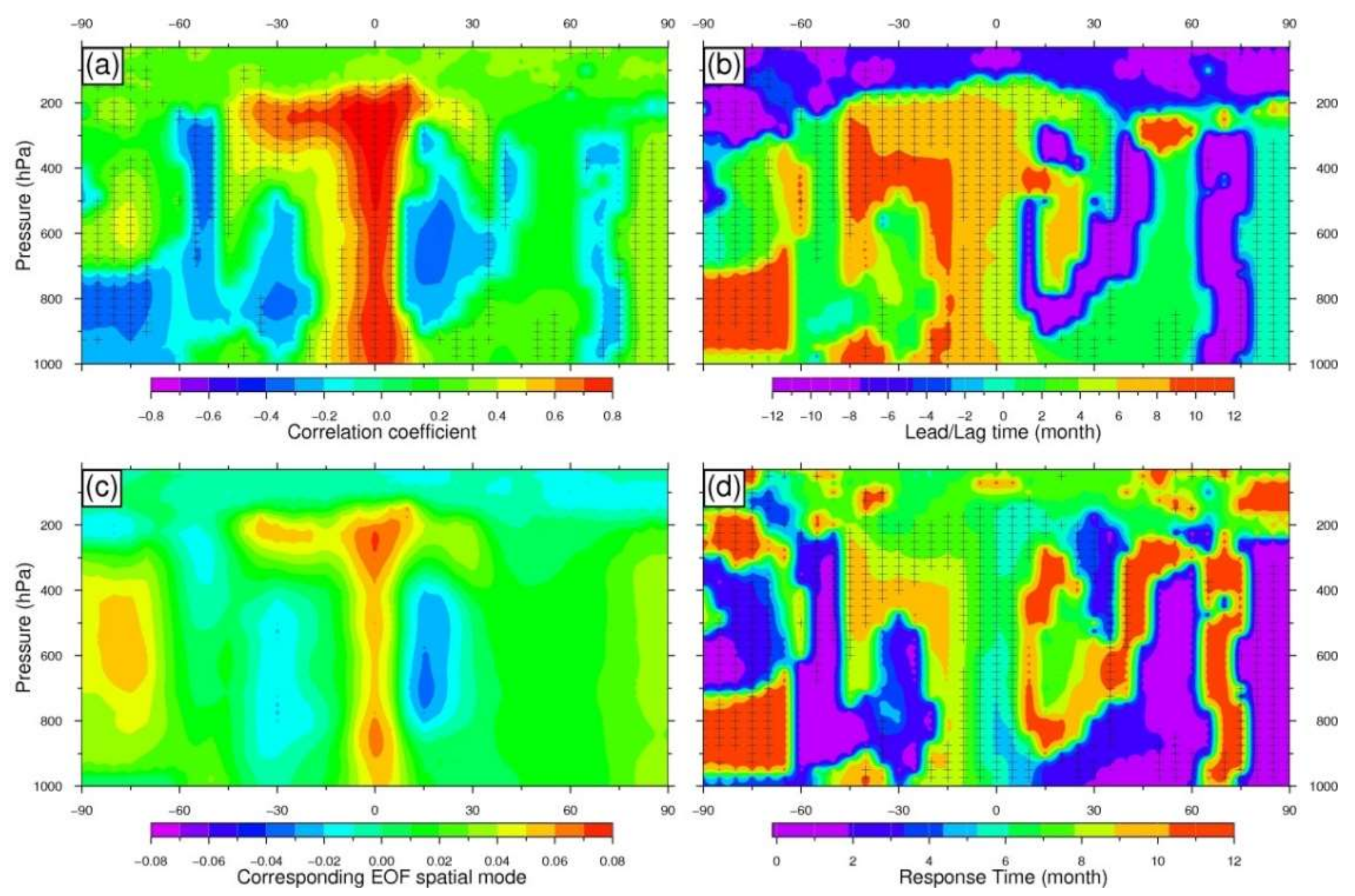
| Abbreviation | Region | Latitude | Longitude |
|---|---|---|---|
| N3.4 | Niño3.4 | −5°S–5°N | 120°W–170°W |
| G5 | Equator | −5°S–5°N | 180°W–180°E |
| G10 | Globe10 | −10°S–10°N | 180°W–180°E |
| G15 | Tropics | −15°S–15°N | 180°W–180°E |
| G20 | Globe20 | −20°S–20°N | 180°W–180°E |
| G25 | Globe25 | −25°S–25°N | 180°W–180°E |
| G30 | Globe30 | −30°S–30°N | 180°W–180°E |
| G35 | Globe35 | −35°S–35°N | 180°W–180°E |
| G40 | Globe40 | −40°S–40°N | 180°W–180°E |
| G45 | Globe45 | −45°S–45°N | 180°W–180°E |
| G50 | Globe50 | −50°S–50°N | 180°W–180°E |
| G55 | Globe55 | −55°S–55°N | 180°W–180°E |
| G60 | Globe60 | −60°S–60°N | 180°W–180°E |
| G65 | Globe65 | −65°S–65°N | 180°W–180°E |
| G70 | Globe70 | −70°S–70°N | 180°W–180°E |
| G75 | Globe75 | −75°S–75°N | 180°W–180°E |
| G80 | Globe80 | −80°S–80°N | 180°W–180°E |
| G85 | Globe85 | −85°S–85°N | 180°W–180°E |
| G90 | Globe90 | −90°S–90°N | 180°W–180°E |
| N30 | Northern30 | 0°N–30°N | 180°W–180°E |
| NHM | Northern Hemisphere Mid-latitudes | 30°N–60°N | 180°W–180°E |
| Arc | Arctic | 60°N–90°N | 180°W–180°E |
| N90 | Northern Hemisphere | 0°N–90°N | 180°W–180°E |
| S30 | Southern30 | 0°S–30°S | 180°W–180°E |
| SHM | Southern Hemisphere Mid-latitudes | 30°S–60°S | 180°W–180°E |
| ANT | Antarctic | 60°S–90°S | 180°W–180°E |
| S90 | Southern Hemisphere | 0°S–90°S | 180°W–180°E |
| Areas | Altitudes (hpa) | EOF Mode | Explaining Variance (%) | Filter Range (month) | Maximum Correlation Coefficient | Lag Time (month) |
|---|---|---|---|---|---|---|
| N3.4 | 250 | 1 | 82.59% | 25 | 0.908 | 5 |
| G5 | 210 | 1 | 34.28% | 20.5 | 0.935 | 6 |
| G10 | 225 | 1 | 34.00% | 21 | −0.940 | 6 |
| G15 | 245 | 1 | 31.17% | 21 | 0.937 | 5 |
| G20 | 245 | 2 | 19.32% | 11.5 | 0.937 | 3 |
| G25 | 235 | 2 | 17.10% | 10.5 | 0.938 | 3 |
| G30 | 235 | 2 | 16.30% | 10.5 | 0.943 | 3 |
| G35 | 235 | 2 | 15.47% | 10.5 | 0.945 | 3 |
| G40 | 245 | 2 | 13.93% | 10.5 | 0.944 | 3 |
| G45 | 245 | 2 | 12.65% | 10.5 | 0.943 | 3 |
| G50 | 245 | 2 | 11.57% | 10.5 | 0.942 | 3 |
| G55 | 220 | 2 | 11.44% | 10.5 | 0.942 | 3 |
| G60 | 220 | 2 | 10.70% | 10.5 | 0.943 | 3 |
| G65 | 220 | 2 | 10.00% | 10.5 | 0.943 | 3 |
| G70 | 220 | 2 | 9.36% | 10.5 | 0.942 | 3 |
| G75 | 220 | 2 | 8.84% | 10.5 | 0.940 | 3 |
| G80 | 245 | 2 | 7.71% | 10.5 | 0.938 | 3 |
| G85 | 245 | 2 | 7.31% | 10.5 | 0.937 | 3 |
| G90 | 245 | 2 | 10.03% | 20.5 | -0.936 | 5 |
| Areas | Altitudes (hpa) | EOF Mode | Explaining Variance (%) | Filter Range (month) | Maximum Correlation Coefficient | Lag Time (month) |
|---|---|---|---|---|---|---|
| N30 | 725 | 1 | 21.67% | 26 | 0.924 | 6 |
| NHM | 95 | 15 | 0.12% | 22.5 | 0.877 | 20 |
| ARC | 90 | 8 | 0.72% | 21.5 | 0.898 | 10 |
| N90 | 785 | 4 | 8.38% | 23.5 | 0.936 | 6 |
| S30 | 55 | 10 | 0.40% | 23.5 | 0.921 | 5 |
| SHM | 250 | 2 | 21.25% | 18.5 | 0.918 | 4 |
| ANT | 640 | 8 | 1.91% | 25 | 0.926 | -21 |
| S90 | 240 | 2 | 11.82% | 12 | 0.937 | 3 |
© 2018 by the authors. Licensee MDPI, Basel, Switzerland. This article is an open access article distributed under the terms and conditions of the Creative Commons Attribution (CC BY) license (http://creativecommons.org/licenses/by/4.0/).
Share and Cite
Chen, Z.; Li, J.; Luo, J.; Cao, X. A New Strategy for Extracting ENSO Related Signals in the Troposphere and Lower Stratosphere from GNSS RO Specific Humidity Observations. Remote Sens. 2018, 10, 503. https://doi.org/10.3390/rs10040503
Chen Z, Li J, Luo J, Cao X. A New Strategy for Extracting ENSO Related Signals in the Troposphere and Lower Stratosphere from GNSS RO Specific Humidity Observations. Remote Sensing. 2018; 10(4):503. https://doi.org/10.3390/rs10040503
Chicago/Turabian StyleChen, Zhiping, Jiancheng Li, Jia Luo, and Xinyun Cao. 2018. "A New Strategy for Extracting ENSO Related Signals in the Troposphere and Lower Stratosphere from GNSS RO Specific Humidity Observations" Remote Sensing 10, no. 4: 503. https://doi.org/10.3390/rs10040503
APA StyleChen, Z., Li, J., Luo, J., & Cao, X. (2018). A New Strategy for Extracting ENSO Related Signals in the Troposphere and Lower Stratosphere from GNSS RO Specific Humidity Observations. Remote Sensing, 10(4), 503. https://doi.org/10.3390/rs10040503





